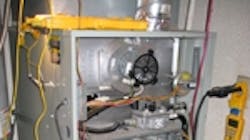I had just bought my first house in March of 2009. It was something of a “fixer-upper,” which made this first time purchase just a little bit more intimidating. I had no idea how much time and money I would have to put into the place.
One of the things that didn’t work when I bought the house was the air conditioning system. Since I’ve been working at Fieldpiece for the past eight years, and was familiar with the procedures and techniques to diagnose an air conditioner, I decided to make a science experiment out of it.
I went a bit above and beyond the usual system exam. I’ll spare you the gory technical details, but by the time I was ready to begin my “fix the air conditioner” experiment, I had 13 data loggers hooked up to the system. These were used to monitor parameters and system performance as I made system modifications.
(If you’re interested in the gory details, I will have a white paper about this on fieldpiece.com soon.)
With the parameters I was measuring, I was able to calculate the real time EER (Energy Efficiency Rating) of the air conditioner while I was working on it, and see what effect my changes were making.
This is a textbook residential split system, with an 80% furnace and an old, 5-ton air conditioning unit in the backyard. After making the necessary repairs to get the system running, I charged it to the 5.7lbs of charge that is recommended on the nameplate, which was pretty tough to read because of the oxide deposits on it.
I used an ASX14 and an ATH4 to perform the CheckMe! test on the air conditioner. Much to my surprise, the system was overcharged when charged to the factory settings. I had zero degrees of superheat and I could hear the compressor struggling. I started recovering the refrigerant, but ended up recovering too much. When I retested the system with the Check Me! program, I found the system was now undercharged.
I charged the unit while watching the readings on the ASX14. The charging process took about 20 minutes to complete and I brought the charge within spec. I then disconnected the DL3s and downloaded the data to my PC. After putting the data into my EER calculations, I received the graph that's shown here (Graph 1).
At 5:36 the system registered as undercharged by the Check Me! switch position. Refrigerant was added and the system was retested at 6:20. As you can see from the graph, the system EER jumped from an average of about 12.5 to an average of about 16. This represents an increase in the efficiency of the air conditioner of 28%.
I knew that charging to superheat was important but was surprised by how much of a difference a quick test and small adjustment in charge can make on a real world system. I certainly gained some appreciation for the job that the technicians do out there in the field and now my air conditioner is ready to save me some money during the summer heat that lies ahead.
Adolfo Wurts is engineering manager for Fieldpiece Instruments, Anaheim, CA.
